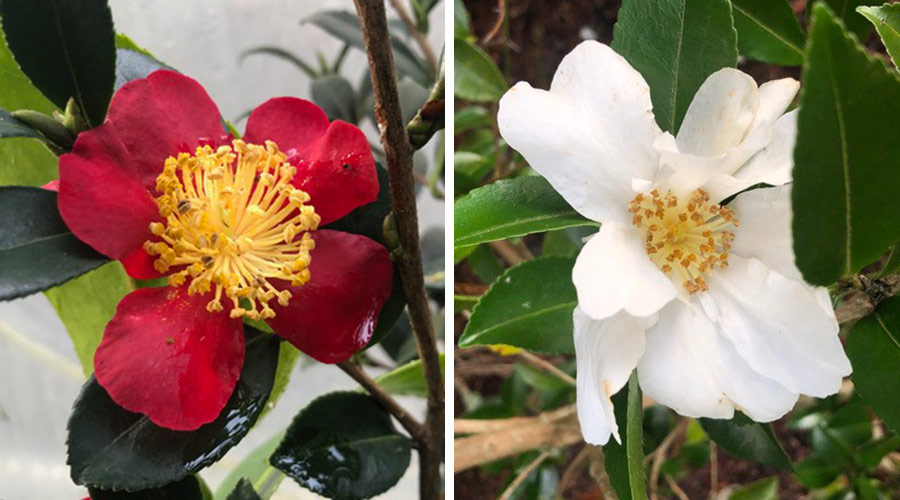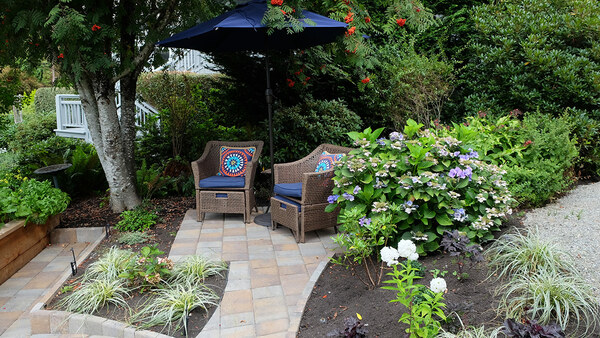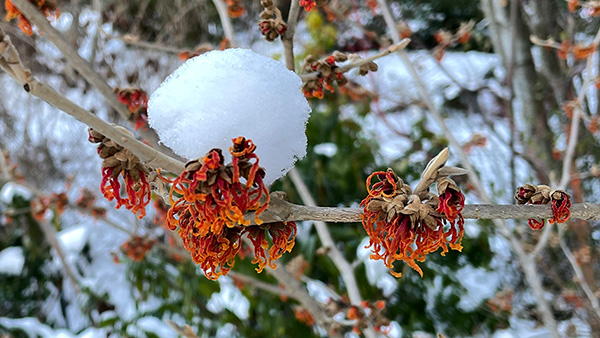
After the torrential rains of December, it is a wonder that anything is blooming in Pacific Northwest gardens. Thankfully there are great plants that survive the downpours and even flourish when everything else is a soggy mess. Along with the plants surviving, there are insects that winter over in the trees, and they love to see the sunshine just like we do. As soon as the lukewarm sun starts hitting the trees, the groggy bees stumble out looking for some food (kind of reminds me of teenagers). It is essential that we gardeners provide early-blooming plants for these very important members of our planet. Interestingly, some bees are not at all particular about their food supply, while others are. Our goal should be to provide both native food sources and ornamental garden food sources. Nature’s creatures have a way of adapting to what is available, but they also search for specifics. The following are a few of my favorite late-winter-blooming plants for pollinators.
‘Charity’ and ‘Soft Caress’ mahonia
I’m not a big native plant person. Growing up here I have seen the native plants in so many places, including open fields, forests, ditches, ponds, roadside edges, and yes, even parking lots. I probably should not go into my opinion of ferns and mahonia in parking lots—that’s another topic. I do, however, have plenty of native/nativar pollinating plants in my garden. The earliest blooming are the fabulous mahonias, including the native creeping mahonia (Mahonia repens, Zones 5–8). I have two other favorites from this genus. The statuesque ‘Charity’ mahonia (M. × media ‘Charity’, Zones 7–9) is a plant that loves partial shade and is quite drought tolerant once established. I’m also a fan of the newly popular ‘Soft Caress’ mahonia (M. eurybracteata ’Soft Caress’, Zones 4–7). This finely textured shrub prefers full to partial shade and acidic soil. ‘Soft Caress’ blooms first in my garden from December through January. ‘Charity’ starts after that and blooms through February. By the time these mahonias are finished there are many native pollen sources blooming in the forest and along edges of streams to fulfill the pollinators’ appetites.
Paperbush
Some nonnative plants also start blooming in January and February. Many of these are also great for hummingbirds that have not left the area and need food. Paperbush (Edgeworthia chrysantha and cvs., Zone 5b–9) has amazing hanging flower heads with yellow, waxy, tubular blooms and a sweet scent that attracts bees and hummingbirds in January and February. It prefers partial shade and evenly moist soil. If you want to do a little more searching, the rare and very cool Japanese red paperbush (E. papyrifera ‘Akebono’, Zones 7b–9b) is striking, with creamy flowers that have tangerine-orange on the inside.
‘Yuletide’ and ‘Setsugekka’ camellia
More common, yet still lovely, are the winter-blooming camellias. Sasanqua camellias are blooming in gardens all around me in late winter. The best ones for pollinators are single-blossom varieties such as ‘Yuletide’ (Camellia sasanqua ‘Yuletide’, Zones 7–10). The brilliant red blooms have a yellow center with prominent stamens. This cultivar will sometimes bloom as early as December. ‘Setsugekka’ (C. sasanqua ‘Setsugekka’, Zones 7–10) has a clear, brilliant white bloom that is a semi-double. The golden yellow center calls out to any passing bee to come closer.
‘Miss Vain’ Scotch crocus
Last but not least are the early-blooming Scotch crocuses. My favorite variety is ‘Miss Vain’ (Crocus biflorus ‘Miss Vain’, Zones 3–8) with its delicate white petals surrounding a boss of honey-yellow stamens. Don’t forget to plant these little puddles of sunshine in your garden; the bees will enjoy them right up until the rest of the landscape explodes with flowers in full spring.
Learn more about gardening for beneficial bugs in the PNW:
- Pollinator Plants for the Northwest
- 7 Simple Ways to Help Pollinators
- How I Grew a Wildflower Meadow in the Pacific Northwest
For more Pacific Northwest regional reports, go here.
Susan Calhoun is the owner of Plantswoman Design in Bainbridge Island, Washington.
Photos: Susan Calhoun






















Comments
Log in or create an account to post a comment.
Sign up Log in